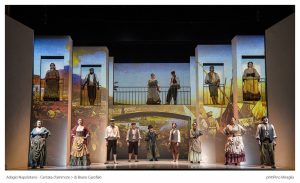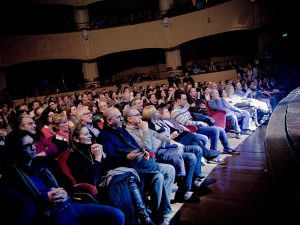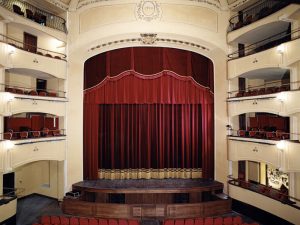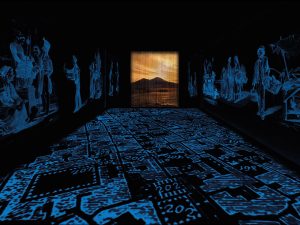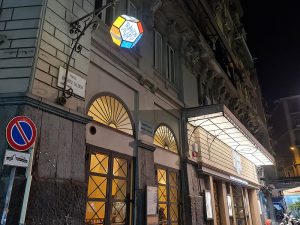TRIANON THEATRE
‘O Trianon
“Trianon” was the name of the village purchased and then destroyed by Louis XIV of France to annex it to the park of the Palace of Versailles. In this luxuriant place the Sun King built “a house where to have a snack”, where he could escape with his family, far from the etiquette and toils of power. This was only the beginning of the development of the area as a royal retreat. Likewise, in the past century the toponym was used to name the theatre that was created as a support for the real estate development of the new elegant insula of the “Risanamento” (urban renewal, literally “making healthy again”) . Next to the “Rettifilo” (the large street, called Corso Umberto I, which takes up the French urban model of the boulevard) the theatre building is located on the Magno- Greek area of the Forcella district, the heart of the ancient city center, declared a World Heritage Site by Unesco Right in front of Piazza Vincenzo Calenda, there are some remains of the city walls of Neapolis (between the 5th and 4th centuries BC), which popular tradition calls “’o cippo a Furcella” (memorial stone of Forcella) and which the collective imagination uses to emphasize its age of something (“S’arricorda ‘o cippo a Furcella!” – it is as old as the memorial stone of Forcella!). The theatre also houses the only watchtower still existing in Neapolis and incorporated into the structure by the builder and first owner of the theater, Amadio Salsi: the Tower of the Siren, so named to evoke the founding myth of Parthenope and her charmer song. The reinforced concrete tectonic system, one of the first examples in Italy, was a precursor to Pier Luigi Nervi and Arnaldo Foschini’s Augusteo Theatre in Naples (1926-29). On 8 November 1911, the theatre was inaugurated with Eduardo Scarpetta‘s successful comedy Miseria e Nobiltà (Misery and Nobility). In its rich centenary history, the Trianon hosted the main artists of the Neapolitan theatrical and musical scene of the twentieth century, from Totò to Mario Merola, who made his debut right here by winning a competition for new voices in 1959. The presence of the major theatrical families (De Filippo, Viviani, Fumo, Maggio) makes this theatre a reference for traditional acting. In the 1930s, with the resident company of Salvatore Cafiero and Eugenio Fumo, the theatre became the stage of choice for “sceneggiata”, the genre of musical theatre that subsequently had a popular revival in the 1970s. During the Fascist era, the theatre changed its name to “Trionfale”, in deference to the linguistic autarchy imposed by the regime. In 1940 Gustavo Cuccurullo bought it to transform it then, in 1947, into the Splendore cinema. Having become a red-light cinema in the 90s, the room was restored to its former theatrical function by another Gustavo Cuccurullo, great-grandson of the previous one. The renovation was designed by architect Massimo Esposito, who also restored the Magna Graecia ruins hosted inside, the “Tower of the Siren” for collective use. The new Trianon was inaugurated on 7 December 2002.
In April 2006, “’o Trianon” - as it has always been affectionately called by Neapolitans – became fully public and was dedicated to the playwright and actor Raffaele Viviani. The Trianon Viviani returns to operate, governed by the foundation of the same name placed under the direction and coordination of the Campania Region and the other founding partner: the Metropolitan City of Naples. The artistic director for the three-year period 2020-2023 is Marisa Laurito, who finally achieves the goal of creating in the city of Naples a theatre dedicated to the great Neapolitan musicality, and so the theatre became “Trianon Viviani”, the theatre of the Neapolitan song, allocating ample active space also to the cultural and social animation of the neighbourhood, attentive to traditional heritage as well as new languages, a unique production centre that also intends to place itself in the wider tourism and leisure market. Inside the Trianon Viviani theater there are many spaces suitable for use for: conventions, school essays, concerts, art exhibitions, private events. ROOM OF WONDERS OF THE NEAPOLITAN SONG As the result of a unique and innovative project in the italian and international scene, the Room of Wonders is a special and “immersive” space. Thanks to the use of digital systems, visitors can virtually explore a Naples of other times. An “immersive walk” of 30 minutes, in which visitors can relive, through sounds, colors and visual projections, the history of Neapolitan song as a true multisensory experience. The contemporary interpretations of the songs, in philological respect of scores and texts, are counterpointed by vintage photos and paintings, with an environmental reconstruction in costume. The considered period goes from the end of the nineteenth century to 1940, the timeframe in which there is the greatest number of musicians and poets involved in the production of the so-called “Classical” Neapolitan song.
Trianon Theatre
| ROOM | SEATS |
|---|---|
| Trianon Theatre | 530 seats |
Website: www.teatrotrianon.org
Phone: +39 081.225.8285
Email: riccio@teatrotrianon.org


